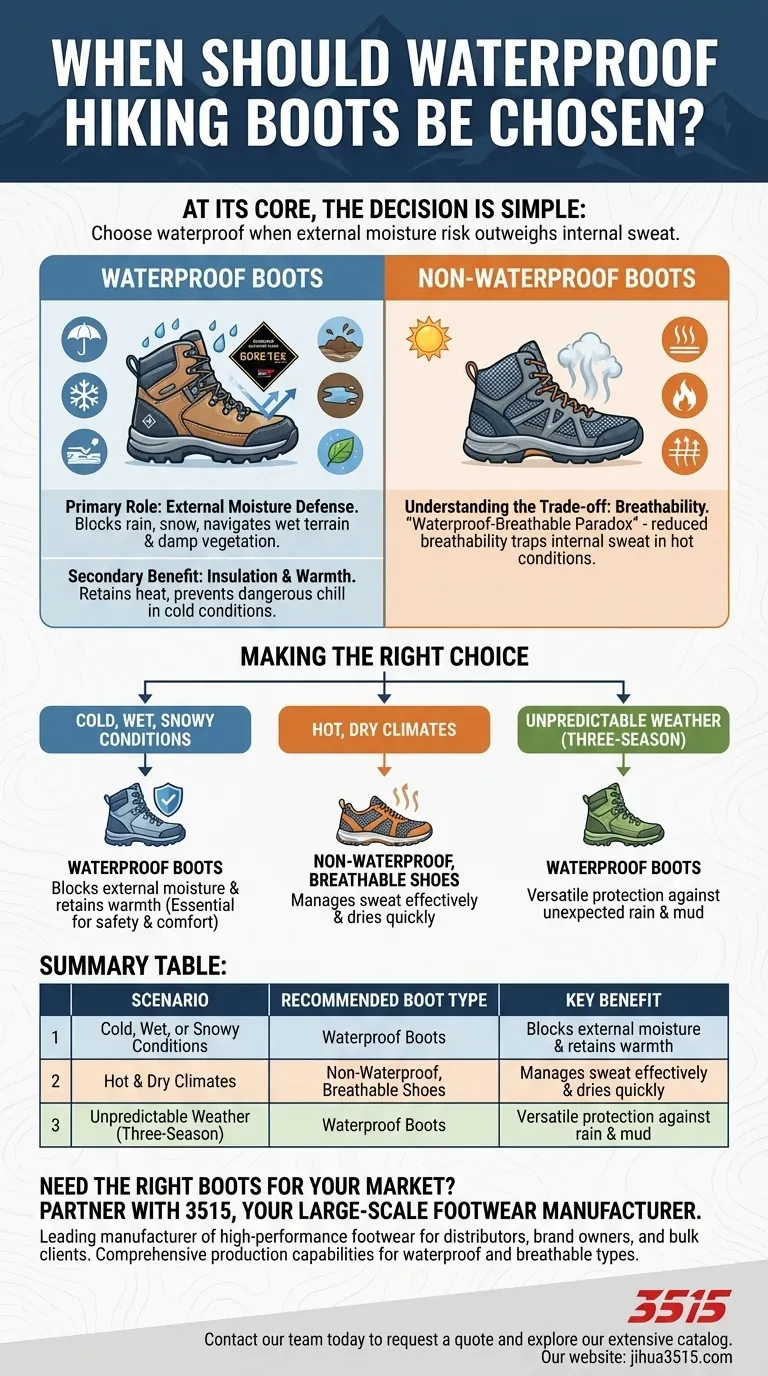At its core, the decision is simple. You should choose waterproof hiking boots whenever your feet are more likely to get wet from the environment than from your own sweat. This typically includes hiking in rain, snow, or mud, crossing streams, or navigating through damp vegetation.
The real choice isn't between a "dry" boot and a "wet" one; it's about managing moisture. Waterproof boots block external water at the cost of trapping internal sweat, while non-waterproof boots manage sweat better but offer no defense against the elements. Your environment dictates which trade-off is the right one.

The Primary Role: External Moisture Defense
The most obvious reason to select a waterproof boot is to create a barrier between your feet and a wet environment. This defense is critical in several common scenarios.
Shielding from Rain and Snow
A waterproof membrane, like Gore-Tex, is designed to prevent water from soaking through the boot's upper material. During a downpour or a hike through snow, this is the single most important feature for preventing discomfort and dangerous heat loss.
Navigating Wet Terrain
Waterproof construction allows you to confidently walk through shallow streams, muddy patches, and deep puddles without a second thought. This protection keeps your feet and socks dry, which is the first line of defense against blisters.
Blocking Damp Vegetation
Even on a clear day, morning dew or leftover rain on trailside brush can quickly saturate a non-waterproof boot. A waterproof model ensures your feet stay dry when the trail itself is narrow and overgrown.
The Secondary Benefit: Insulation and Warmth
Beyond blocking water, the construction of waterproof boots provides an additional benefit that is crucial in colder climates.
Retaining Heat in Cold Conditions
The same membrane that blocks water molecules also traps air. This trapped air acts as a layer of insulation, making waterproof boots inherently warmer than their non-waterproof counterparts of a similar weight.
Preventing a Dangerous Chill
Wet feet lose heat dramatically faster than dry feet. In cold or freezing conditions, keeping your feet dry isn't just about comfort—it's a critical safety factor for preventing frostbite and hypothermia.
Understanding the Critical Trade-off: Breathability
The promise of a perfectly dry foot is appealing, but it comes with a significant compromise that can backfire in the wrong conditions.
The "Waterproof-Breathable" Paradox
Modern membranes are remarkable, but they are not magic. While they are designed to let water vapor (sweat) escape, they can never move that moisture as efficiently as the open mesh of a non-waterproof shoe. There is always a reduction in breathability.
The Problem of Internal Moisture
In warm or hot conditions, your feet sweat. If that sweat cannot escape faster than you produce it, your socks will become damp from the inside. This moisture can lead to the same blisters and discomfort you sought to avoid by choosing a waterproof boot in the first place.
Why Non-Waterproof Wins in the Heat
For hiking in hot, dry climates, a highly breathable, non-waterproof shoe is the superior choice. If you do encounter a stream crossing, the shoe is designed to drain quickly and dry out from your body heat and the ambient air while you walk.
Making the Right Choice for Your Hike
To select the right boot, stop thinking in absolute terms of "good" or "bad." Instead, match the boot's strengths to the demands of your environment.
- If your primary focus is hiking in cold, wet, or snowy conditions: A waterproof boot is non-negotiable for safety and comfort.
- If your primary focus is hiking in hot, dry climates with predictable weather: A non-waterproof, highly breathable shoe will keep your feet drier and more comfortable by managing sweat effectively.
- If your primary focus is "three-season" hiking with unpredictable weather: A waterproof boot offers the most versatile protection against unexpected rain and the muddy trails that follow.
By understanding the fundamental trade-off between external protection and internal breathability, you can select the boot that truly serves your environment and your feet.
Summary Table:
| Scenario | Recommended Boot Type | Key Benefit |
|---|---|---|
| Cold, Wet, or Snowy Conditions | Waterproof Boots | Blocks external moisture & retains warmth |
| Hot & Dry Climates | Non-Waterproof, Breathable Shoes | Manages sweat effectively & dries quickly |
| Unpredictable Weather (Three-Season) | Waterproof Boots | Versatile protection against rain and mud |
Need the Right Boots for Your Market? Partner with 3515, Your Large-Scale Footwear Manufacturer.
As a leading manufacturer, 3515 produces a comprehensive range of high-performance footwear for distributors, brand owners, and bulk clients. Whether your customers need durable waterproof boots for cold, wet trails or breathable shoes for hot climates, our production capabilities encompass all types of shoes and boots.
Let's discuss how we can help you supply the perfect footwear for your target market.
Contact our team today to request a quote and explore our extensive catalog.
Visual Guide

Related Products
- Factory Direct Wholesale Rain Boots Durable Waterproof & Fully Customizable
- Safety Footwear Wholesale Manufacturer for Custom OEM/ODM Production
- Wholesale High-Traction Camo Boots - Custom Manufacturer for Brands
- High Performance Fire-Retardant Waterproof Safety Boots
- Factory-Direct Wholesale Canvas Boots with High-Traction Rubber Soles
People Also Ask
- What are rain boots made of? Discover the best materials for ultimate waterproof protection.
- What are the main materials used in the production of rain boots? A Guide to Durability & Comfort
- What are the key characteristics of rain boots? Essential Features for Total Dryness
- What factors should be considered when choosing rain boots? Find the Perfect Boot for Your Needs
- What are the limitations of rain boots in certain climates? Find the Right Footwear for Your Weather



















